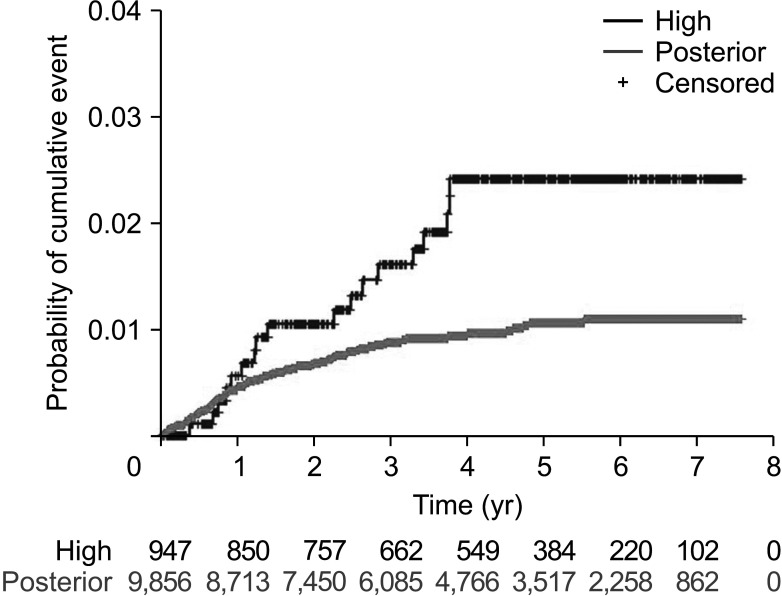Ann Surg Treat Res.
2024 Apr;106(4):231-236. 10.4174/astr.2024.106.4.231.
High ligation with posterior wall repair for inguinal hernia repair in young adults: a nationwide cohort study
- Affiliations
-
- 1Department of Surgery, Uijeongbu St. Mary’s Hospital, College of Medicine, The Catholic University of Korea, Seoul, Korea
- 2Department of Biomedicine Health Science, College of Medicine, The Catholic University of Korea, Seoul, Korea
- KMID: 2554483
- DOI: http://doi.org/10.4174/astr.2024.106.4.231
Abstract
- Purpose
This study evaluated the difference in the recurrence of inguinal hernia in young adult patients who underwent either high ligation alone or high ligation with posterior wall repair using nationwide data.
Methods
This retrospective study included young adult patients (aged 16–30 years) who underwent surgery for inguinal hernia between June 1, 2013 and December 31, 2020. Data from the National Health Information Database from the Korea Health Insurance Service were used for this study. Patients were divided into 2 groups (high ligation alone and posterior wall repair). The primary outcome was the difference in recurrent inguinal hernia surgeries between the 2 groups.
Results
Among the 10,803 patients included in the study, 947 underwent high ligation alone, and 9,856 underwent high ligation with posterior wall repair. Recurrence was observed in 18 patients (1.9%) in the high ligation only group and 84 (0.85%) in the high ligation with posterior wall repair group. Log-rank test findings revealed that recurrence was less frequent in the high ligation with posterior wall repair group than in the high ligation only group (P = 0.003). In the multivariate analysis of factors influencing recurrence, posterior wall repair (hazard ratio, 0.241; P = 0.001) was shown to significantly lower the recurrence.
Conclusion
Posterior wall repair might be necessary for inguinal hernia repair in young adults.
Keyword
Figure
Reference
-
1. Han SR, Kim HJ, Kim NH, Shin S, Yoo RN, Kim G, et al. Inguinal hernia surgery in Korea: nationwide data from 2007-2015. Ann Surg Treat Res. 2019; 97:41–47. PMID: 31297352.2. Hammoud M, Gerken J. Inguinal hernia. StatPearls [Internet]. StatPearls Publishing;2024. 01. Updated 2023 Aug 8. cited 2023 Nov 30. Available from: https://www.ncbi.nlm.nih.gov/books/NBK513332/ .3. HerniaSurge Group. International guidelines for groin hernia management. Hernia. 2018; 22:1–165.4. Gauderer MW, Cina RA. Chapter 36: Hernias of the inguinal region. Ziegler MM, Azizkhan RG, Allmen Dv, Weber TR, editors. Operative pediatric surgery. 2nd ed. McGraw-Hill Education;2014. p. 489–509.5. van Kerckhoven G, Toonen L, Draaisma WA, de Vries LS, Verheijen PM. Herniotomy in young adults as an alternative to mesh repair: a retrospective cohort study. Hernia. 2016; 20:675–679. PMID: 27522362.6. Criss CN, Gish N, Gish J, Carr B, McLeod JS, Church JT, et al. Outcomes of adolescent and young adults receiving high ligation and mesh repairs: a 16-year experience. J Laparoendosc Adv Surg Tech A. 2018; 28:223–228. PMID: 29261090.7. oethals A, Azmat CE, Adams CT. Femoral hernia. StatPearls [Internet]. StatPearls Publishing;2024. 01. updated 2023 Jul 31. cited 2023 Nov 30. Available from: https://www.ncbi.nlm.nih.gov/books/NBK535449/ .8. DeLancey JO, Blay E, Hewitt DB, Engelhardt K, Bilimoria KY, Holl JL, et al. The effect of smoking on 30-day outcomes in elective hernia repair. Am J Surg. 2018; 216:471–474. PMID: 29559083.9. Schjøth-Iversen L, Refsum A, Brudvik KW. Factors associated with hernia recurrence after laparoscopic total extraperitoneal repair for inguinal hernia: a 2-year prospective cohort study. Hernia. 2017; 21:729–735. PMID: 28752424.10. Lee CS, Kim JH, Choi BJ, Lee JI, Lee SC, Lee YS, et al. Retrospective study on prevalence of recurrent inguinal hernia: a large-scale multi-institutional study. Ann Surg Treat Res. 2020; 98:51–55. PMID: 31909050.
- Full Text Links
- Actions
-
Cited
- CITED
-
- Close
- Share
- Similar articles
-
- High Ligation for Indirect Inguinal Hernia in Young Adults
- Laparoscopic High Ligation of Hernia Sac of Inguinal Hernia in Pediatric Patients
- To Minimize Post-operative Pain in Inguinal Hernia Repair: Single-port Laparoscopic Totally Extraperitoneal Inguinal Hernia Repair without Fixation of the Mesh
- Long-term Outcome of Laparoscopic Hernia Sac Transection and Intracorporeal Ligation in Children: A Single Center Cohort Study
- A Preliminary Report of Laparoscopic Hernia Repair in Children



